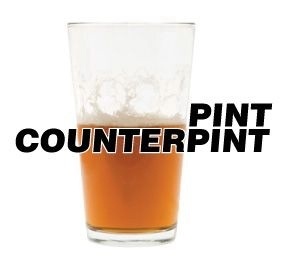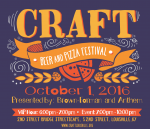 Pint/CounterPint was created out of necessity when Adam Watson (Against the Grain Brewery) wrote a loving response to the first Baylor on Beer article, Know your Enemy, written by Roger Baylor (New Albanian Brewing Company). At first we laughed whole-heartedly and admired the conviction and stance of both parties, and then we thought, “Hey, wait a minute… remember that old 60 Minutes segment called Point/Counterpoint?”
Pint/CounterPint was created out of necessity when Adam Watson (Against the Grain Brewery) wrote a loving response to the first Baylor on Beer article, Know your Enemy, written by Roger Baylor (New Albanian Brewing Company). At first we laughed whole-heartedly and admired the conviction and stance of both parties, and then we thought, “Hey, wait a minute… remember that old 60 Minutes segment called Point/Counterpoint?”
For those of you that don’t, Point/Counterpoint was a segment of the CBS Television News Magazine, 60 Minutes. Point/Counterpoint was a debate between spokespeople for the political right and left, respectively. This segment pioneered a format that would later be adapted by CNN for its Crossfire show. LouisvilleBeer.com adopted the format for an online debate between Adam and Roger. Welcome to Round 3. DING!
…………………………………………
Pint/CounterPint 3:1
Arts and Crafts
by Adam Watson, Against The Grain Brewery
With all due respect to the folks at the Brewer’s Association, I staunchly disagree with their determination of craft beer as anything made by a brewer who is small (6 million annual barrels or less), independent (less than 25% owned by non-craft brewers), and traditional (all malt flagship or 50% or more sales in all malt beers). They may be the guiding hands of our market, but they have missed the point of craft beer. Maybe quantities and percentages are useful in making business determinations, but they fail in capturing spirit. For many of us, craft beer is certainly a business, but foremost it should be art.
I realize that saying craft beer is art throws us headlong into the brutal and unresolvable quandary of defining art, but for the love of beer, we shall brave that maelstrom. In the interest of keeping this article under nine thousand pages, let us use Tolstoy as a jumping off point. In his insightful essay, “What is Art?”, our buddy Leo ventured that “Art is a human activity consisting in this, that one man consciously, by means of certain external signs, hands on to others feelings he has lived through, and that other people are infected by these feelings and also experience them.” This definition of art seems agreeable in most respects. The one modification I would make is that, where Tolstoy seems to require that the same emotion be communicated from artist to audience, I require only that some emotion be communicated, even if the audience experiences something entirely different from what the artist experienced. As some of our revered friends have said, craft beer is art in fermented form. It stands to reason, assuming this is true, that craft beer can be any beer that sprang forth from some emotion of the brewer and results in some emotional evocation in the drinker.
If craft beer must be small, is that six-million-and-first barrel not craft? Does it render all the previous barrels un-craft? I think not. Does the eventual target of the proceeds change the nature of the product? A craft beer is craft beer no matter who gets the money when the drinker buys it because the product has not necessarily changed. Can a propensity for extreme experimentation render your product less-than-craft? I think not. I have had plenty of great beers that are not all-malt, and making those a flagship would not diminish a brewer’s position as craft in my eyes. In fact, the ability to push the boundaries of definition is one of the things that allows a skilled brewer to create art in the form of craft beer.
For the business of craft beer, let the BA definition stand. For the art of craft beer, let it be any brew that the brewer infuses with emotion and uses to raise emotion in the drinker.
Pint/CounterPint 3:2
In defense of the BA’s craft definition
by Roger A. Baylor, New Albanian Brewing Company
There was a time when I wouldn’t have been caught dead agreeing with a point espoused by Charlie “Capitulation” Papazian. Even the suggestion of such cooperation would have elicited a reaction similar to what happens when someone hands me a can of Miller Lite and says, “Drink deeply of the triple-hopped nectar, ol’ buddy.”
(Insert epithet here, and hear the sound of vile liquid meeting pavement)
Times change, and since Papazian’s mid-1990’s ethical nadir, when he suffered from a pathological fear of being quoted on issues of cosmological significance to the good beer revolution, he miraculously has progressed to a point of having his own (as ever self-aggrandizing) Twitter feed. Nowadays, at least Charlie occasionally finds it expedient to display traces of a faint political consciousness. Good for him … and it’s about damned time.
The Brewers Association always has been Papazian’s baby, but despite this, NABC is a dues-paying member, and as a brewery owner, I usually support the BA’s work. In essence, the BA educates and lobbies on behalf of that rarified portion of the American beer business which DOES NOT exist to choke the marketplace with flavorless mass-market swill, and as such, the BA’s constituency is given a snappy identity (“craft”) and a definition seeking to define the nature of craft:
“An American craft brewer is small, independent and traditional.”
- Small: Annual production of 6 million barrels of beer or less. Beer production is attributed to a brewer according to the rules of alternating proprietorships. Flavored malt beverages are not considered beer for purposes of this definition.
- Independent: Less than 25% of the craft brewery is owned or controlled (or equivalent economic interest) by an alcoholic beverage industry member who is not themselves a craft brewer.
- Traditional: A brewer who has either an all malt flagship (the beer which represents the greatest volume among that brewers brands) or has at least 50% of its volume in either all malt beers or in beers which use adjuncts to enhance rather than lighten flavor.
Granted, the buffing, polishing, juggling and balancing on display here is worthy of a medieval philosopher at his finest. Beyond determining how many craft beers can pour from the head of a pin, the Brewers Association must always perform the delicate task of ensuring that Samuel Adams’s production remains inside its tent (to do otherwise would tilt market share statistics downward), while unflinchingly banishing previous category stalwarts when they are purchased by mass market outliers or otherwise become corrupted by the wrong color of money.
So, does it really matter what “craft” is? Don’t we know it when we taste it? Can’t we all just get along?
Actually, it matters very much to try to be clear about what craft is, and what it is not — even when we think we know who is who and what is what. That’s because others new to the genre might not know, and in order to confuse them, the marketing maven deploys semantic subterfuge, and the big boys use their in-house mockrobrews and former craft brand acquisitions to seize and hold shelf space to the detriment of genuine craft players.
Perhaps a measure of co-existence is possible, but this isn’t the same as peace, love and understanding. The beer market is more complex than civilians realize. Mostly it is a struggle for survival and pre-eminence, and in wartime, ideology really does have an impact. It shapes viewpoints, provides a framework for action, and rallies the troops. WE are craft beer, and THEY are not. Love it or hate it, it’s necessary to us to know the difference.
For so long as the multinationals remain tantamount to 800-lb gorillas with the strength to derail the craft revolution – and you can bet that final share of AB Inbev stock reposing in a Swiss bank’s lock box that indeed they do – it will be useful to have a definition of craft, even if it is subject to evolution, and the BA’s bid is as coherent as any.
It is my fond hope that with time, the need for battle lines will wither away, but in craft beer as in any other negotiation, a position of strength and clarity is preferable to one without them. Here are the rest of the Brewers Association’s thoughts on the matter.
The following are some concepts related to craft beer and craft brewers:
- Craft brewers are small brewers.
- The hallmark of craft beer and craft brewers is innovation.
- Craft brewers interpret historic styles with unique twists and develop new styles that have no precedent.
- Craft beer is generally made with traditional ingredients like malted barley; interesting and sometimes non-traditional ingredients are often added for distinctiveness.
- Craft Brewers tend to be very involved in their communities through philanthropy, product donations, volunteerism, and sponsorship of events.
- Craft Brewers have distinctive, individualistic approaches to connecting with their customers.
- Craft Brewers maintain integrity by what they brew and their general independence, free from a substantial interest by a non-craft brewer.
- The majority of Americans live within ten miles of a craft brewer.





